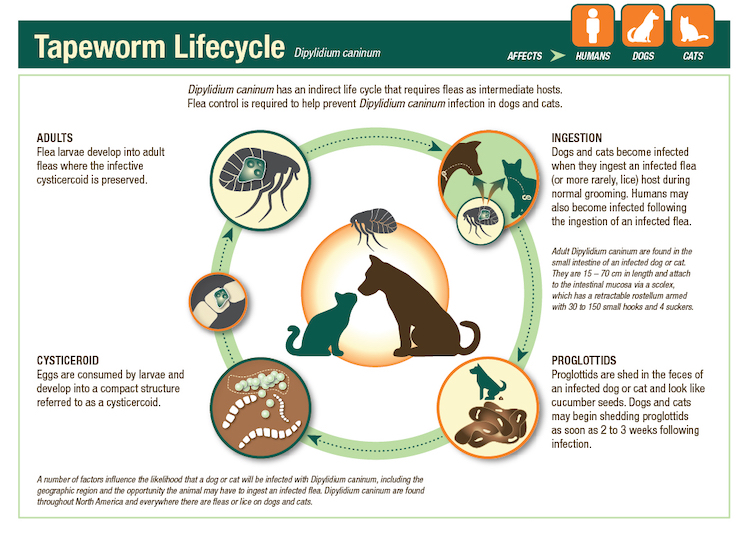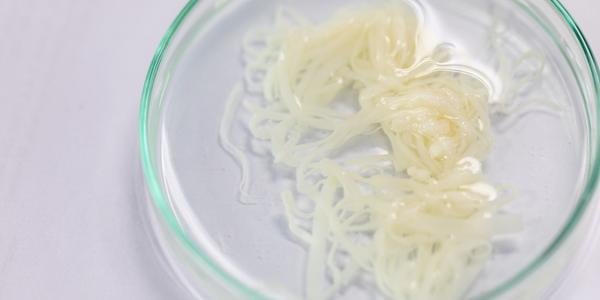 Have you ever heard the beginning words of the "Addams Family" theme song? It begins like this, "They're creepy, and they're kooky, mysterious and spooky, they're altogether ooky ..." If you ask me, this perfectly describes tapeworms!
Have you ever heard the beginning words of the "Addams Family" theme song? It begins like this, "They're creepy, and they're kooky, mysterious and spooky, they're altogether ooky ..." If you ask me, this perfectly describes tapeworms!
If you've never seen them before, it can be quite a surprise when you notice them in your pet's feces. But fortunately, treatment is straightforward, and there are things you can do to prevent them in the future.
Before we jump into things, here is a freaky fact about tapeworms: In the early 1900s, a tapeworm diet emerged.
People would consume tapeworms to lose weight! Fortunately, this risky fad diet wiggled its way out of fashion.
Skip Ahead
What is a Tapeworm?
Even though there are many types of tapeworms, some of which can cause deadly diseases, the most common type to infect cats and dogs is Dipylidium caninum.
This parasite is called a tapeworm because it looks like tape. While not original, it is accurate.
These flat worms have a head with six sets of hook-like teeth that are used to attach to the intestinal lining and make themselves at home in your pet’s intestines and feed on the food they eat.
Tapeworms have a "neck" that separates the head from the "body." The body is made up of multiple individual segments called proglottids.
Each segment has its own reproductive system (that's one reason they are kooky!). Each of these segments is about 1/8 of an inch long.
These worms can range in size from 15 to 70 cm in length — that's up to 30 inches!
When the adult tapeworm matures, these segments can separate from the worm’s body and pass into your pet’s poop ("creepy" and "icky," right?).
How Does Your Cat or Dog Get Tapeworm?
You may be wondering how in the world your pet got tapeworms. A dog or cat gets tapeworms by ingesting a flea that contains tapeworm eggs.
Infection happens more easily than you may think. Your pet can lick or chew their skin and swallow a flea. They can be licking your pant leg and ingest one that had come along for the ride.
Cats and even some dogs that hunt mice, birds, rabbits, etc., can easily ingest several fleas. And if your dog likes to root around in your yard or on hikes, they may swallow a flea while munching on leaves or grass.
About 2 to 3 weeks after the initial infection, you may start seeing the worm segments in their poop.

Symptoms of Tapeworm in Cats and Dogs
Unlike other parasites found in the intestines, such as hookworms or roundworms, routine fecal examinations are not generally helpful in diagnosing tapeworms. The eggs do not routinely float, and the proglottids are not evenly distributed in the poop.
There was a study conducted on shelter cats that showed over one hundred cats had no eggs identified in the fecal examination, but they had tapeworms in their intestines.
So how do you know if your pet has tapeworms? There are a few gross observations you may make.
- The worm segments can dry on the fur around your pet’s rump, resembling grains of rice or cucumber seeds.
- There may be white, flat segments moving around on your pet’s poop or in their vomit. (See an example of this in the video below.)
- There are times a whole worm will pass and appear as a slimy indistinct mound of string.
- Your pet may scoot due to an itchy rear end.
- Blackish specks around their tail base indicate they have fleas and likely have ingested a few.
If you notice any of these things, it is time to contact your veterinarian.
Providing them with pictures or videos of the tapeworm (who wouldn’t want an image of poop with a tapeworm on it!) or even bringing your vet a sample in a baggie will help them make their diagnosis.
If you want to see what a tapeworm looks like, the video below shows one moving on some fresh dog poop.
Generally, there are no noticeable signs of illness in a pet with tapeworms. But some symptoms you may notice include:
- Gastrointestinal upset
- Abdominal discomfort
- Changes in appetite
- Weight loss
- Poor skin and coat
Even if your dog or cat seems fine, it is important to have them treated if you suspect tapeworms since they compete for essential nutrients.
How to Treat Tapeworms in Dogs and Cats
Your veterinarian will look for what looks like ‘rice’ attached to the fur around your pet's rump, or they'll see proglottids moving (looks like flat maggots) on their stool, and sometimes, though not often, they'll notice eggs in a fecal sample.
But if a pet is infested with fleas, they likely have tapeworms and should be treated once fleas are treated.
The good news is treatment is easy and effective.
Your veterinarian will prescribe a deworming medication, which can be oral or injectable, that will kill the tapeworms.
In cases where there is an ongoing flea infestation, multiple treatments will likely be recommended. It is generally recommended for outdoor pets, especially cats that hunt, to be treated for tapeworms every 4 to 6 months.
There are some heartworm preventives (Interceptor® Plus or Sentinel Spectrum®) that contain a deworming medication that controls and treats tapeworms.
While these particular preventatives may be more costly than other parasite preventatives, they may be beneficial for those pets who repeatedly get tapeworms.

Serious Safety Note Regarding Certain Preventatives: Some dogs and cats may carry a genetic mutation (MDR1) that makes them sensitive to common medications including some preventatives. If your pet has this mutation, standard doses (or any use) could cause severe adverse reactions.
An MDR1 test can help your veterinarian tailor safe and effective treatments. Click here for a full list of medications for cats to be cautious about, a full list of medications for dogs to be cautious about, and to order tests.
How to Prevent Tapeworms
Once you have experienced tapeworms, most people prefer to never see them again. To help avoid or prevent re-infection, here are some helpful tips:
- Controlling fleas is the best prevention. Routinely use flea prevention for your pet.
- Groom your pet regularly. Be sure to look for flea dirt, which looks like brown or black specks.
- Routinely wash your pet’s bedding in hot water to be sure to kill any fleas that may be hiding.
- Thoroughly vacuum everywhere in your home, including on and under furniture.
- Treat your yard or outdoor space for fleas.
Even indoor-only pets should have flea prevention! Fleas can hitchhike a ride on you to sneak indoors. If your pet has had fleas, it is important to treat your home for fleas, too.
Typically, this requires multiple treatments. Check out our article for more info on getting rid of fleas in your home and yard.
While these creepy, kooky, and icky parasites are not anyone’s favorite guests, they are generally harmless and easy to prevent and treat.
Remember — the key to success is being diligent with flea prevention and observing your pet (especially their poop!).



